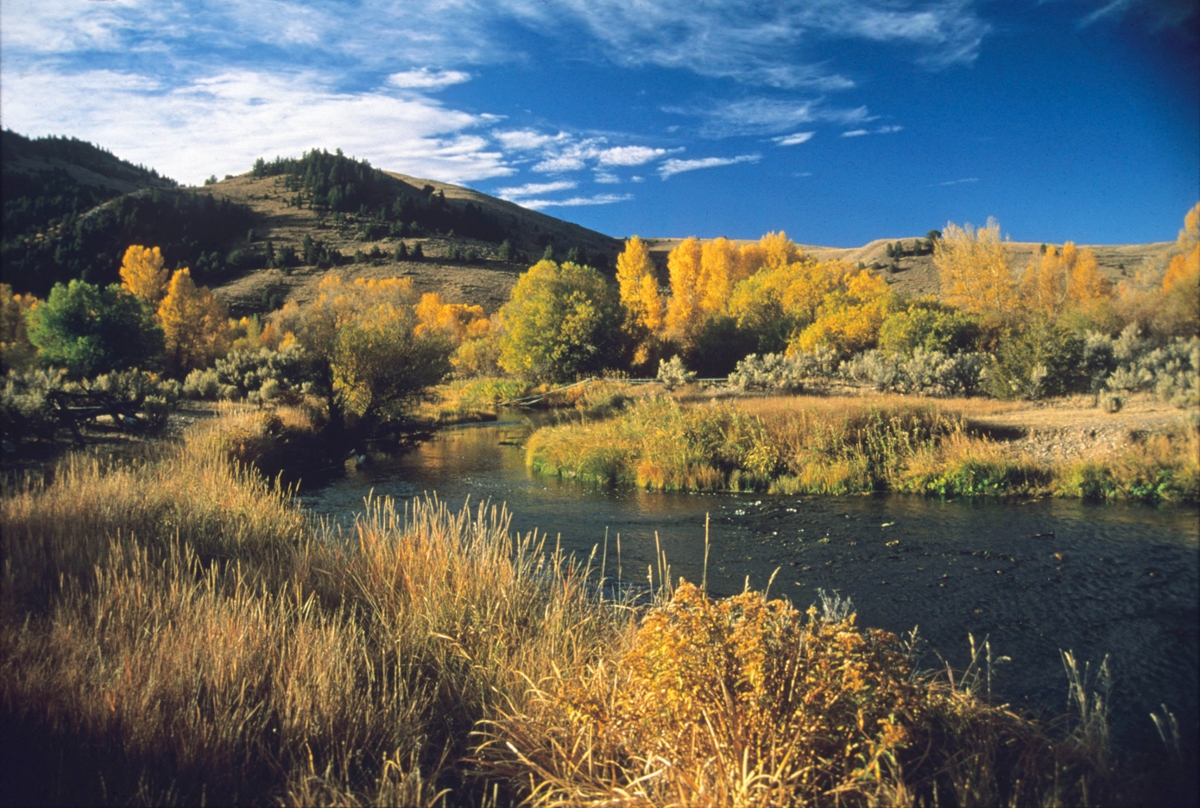Gold Gives Birth to Western Montana
 Aspen leaves turn gold along Grasshopper Creek below present day Bannack, the location of Montana’s first major gold strike. (Photo by Rick and Susie Graetz)
Aspen leaves turn gold along Grasshopper Creek below present day Bannack, the location of Montana’s first major gold strike. (Photo by Rick and Susie Graetz)
Following quickly on the heels of Lewis and Clark, fur trappers flocked to what would later become Montana Territory. Canadians came within months of the Corp of Discovery. In fall 1807, Finian McDonald entered the northwest corner of the state and built the Kootenai Post near present day Libby. In November 1809, David Thompson established the Saleesh House on the Clark Fork River near Thompson Falls. Others, like the legends Jim Bridger, John Colter, James Kipp and Manuel Lisa, came later.
Thompson, probably the first white man to see Flathead Lake (the Indians called it Salish), explored much of this untracked wilderness and mapped the Missoula area from the top of today’s Mount Jumbo or Waterworks Hill while there was snow on the ground. His maps of the region were remarkably accurate.
The trappers were not settlers; they just passed through the country. Fur trading prospered until about 1840 when the colorful era of the mountain man began phasing out, leaving behind a mostly negative legacy that included degradation of indigenous peoples and a depletion of a resource that saw profits flow to only a few.
Catholic priests soon entered the region, establishing missions such as one at St. Ignatius in 1854 and later in the Bitterroot at St. Mary’s.
In western Montana, gold was the basis of the first permanent white settlement. The initial discovery was recorded in the spring of 1858 at Gold Creek, just east of Drummond, by brothers Granville and James Stewart, along with their partner Reece Anderson. In July of 1862, a gold rush to Montana started based on news of an initial big strike at Grasshopper Creek by John White. Bannack, the first territorial capital of Montana, given that distinction on May 26, 1864, was born. As word of this and other finds reached the eastern United States and Europe, would-be miners crowded onto the steamboats, coming up the Missouri River to Fort Benton and then ventured overland to the gold camps of western Montana. Others trailed north from the fields of Colorado, Nevada and California that had boomed in the 1840's and 1850's.
One year after Bannack’s beginnings, more than 2,000 people had moved into the creek bottom and surrounding hills. The population included some of the most famous characters of the Old West, as well as a collection of outlaws. Amongst these infamous individuals was Sheriff Henry Plummer and his gang of road agents. Their kind brought on the formation of the Vigilantes by the citizens of Bannack and nearby Virginia City to deal out frontier justice.
In May of 1863, a find in Alder Gulch – 45 miles northeast of Bannack – proved to be the largest of all of Montana’s gold strikes and spawned Nevada City and Virginia City. The treasure in Bannack played out, and in 1865, Virginia City became the second territorial capital. In that period, 10,000 people massed into the rugged area.
In July of 1864, “the Four Georgians” out of Virginia City discovered colors in today’s Last Chance Gulch, and Helena came into being. By 1875, this “gold town” took on some permanence and replaced Virginia City as the territorial capital. In 1889, Montana was granted statehood and Helena became the permanent capital. And while gold was still king in the 1880's, Helena had more millionaires per capita than any place in the country. Records show there were 50.
Many other rich “boomtowns” grew out of the frantic search for the yellow metal, as well as from silver discoveries. Granite, Elkhorn, Confederate Gulch, Diamond City, Montana City, Garnet, Coloma, Horse Prairie Creek, Southern Cross, Pony and Marysville were but a few of the legendary camps.
The period of the 1860's through the 1880's was a turbulent and wild time in Montana. But by the 1890's, gold began taking a secondary role to copper, and Butte became a major town and producer of the metal. Considered one of the most prolific mining districts in the world, Butte earned the title “Richest Hill on Earth.” In the late 1880's, it was also a prominent producer of silver, a byproduct of copper.
The miners and their needs attracted merchants, and soon, cattlemen came to feed them. Big ranches, many still operating today, were established. Communities sprung up in northwest Montana a little later as a result of the railroad and the timber industry taking hold. While some gold and silver were found in the northwest part of the state, most mining was confined to the southwestern gulches and valleys. As the precious metals played out, most of the towns surrounding the mines withered away. Only a few of the first settlements, including Butte and Helena, prospered and lasted.
Today, the hills and mountains of western Montana harbor many relics of the boisterous mining days. Discovery pits, old mine shafts, collapsed buildings and ghost towns serve to remind us of western Montana’s beginnings.
Rick and Susie Graetz | University of Montana | Department of Geography
